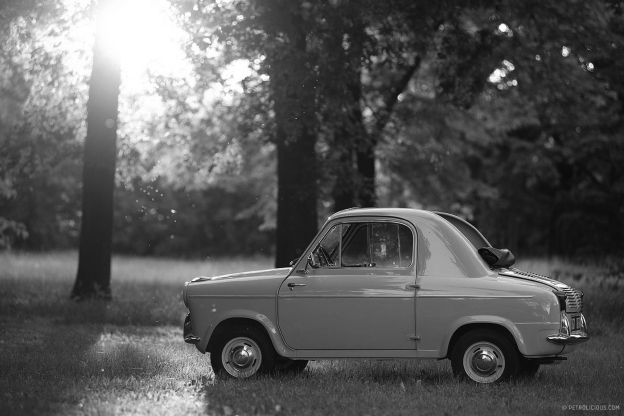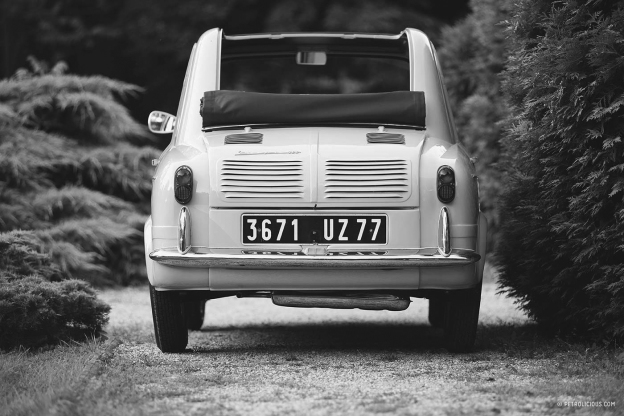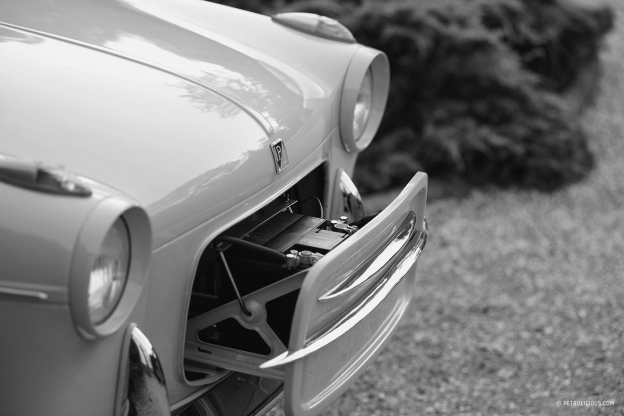One day, coincidentally, you’re flipping through a classic car magazine and see a picture of a rare microcar designed in Italy and built in France. Five years later a perfectly restored example sits in your garage and you are producing and selling parts for these cars all over Europe, helping other enthusiasts to turn their dream into reality. Such is the story of this sole Hungarian Vespa 400’s owner.

Microcars attained a special distinction for themselves in transportation history. Most of them were built during the economic crisis that WWII left behind in Europe and they used to be kind of rolling raincoats and motorized shopping carts. Their design was driven by three things: low cost, functionality, and simplicity. Nowadays simplicity means clean lines, minimalism etc., back then it was pure functionality. Passengers (usually two max) of the liliputians sat on tubular metal frame seats, they looked at a naked dashboard with only a speedo and a few knobs while they dreamed of reaching forty-five mph on a straight road (if there was no headwind).
A few decades passed and nearly all of these diminutive autos became fashion items and a means of self-expression for scoiety’s different layers. Just take at look at their increasing prices and you’ll immediately face a well-known fact: extravagance costs a lot.
I first saw a Vespa 400 when I joined the Hungaria Classic and a small blue thing bounced along the road, ahead of me. Luxury cars of the sixties and seventies passed by, but I couldn’t take my eyes off of the unknown vehicle. At the first stop, I read “Vespa” on the back with surprise. People usually associate this name with charming scooters and it isn’t part of the basic education that four-wheelers were also born under this brand. It shouldn’t come as a surprise though, as the 400cc Vespa was built at ACMA (Ateliers de Constructions de Motors et Accessoires) in Fourchambault, France, because Mr. Gianni. Agnelli didn’t approve Vespa’s entry into “his” market against the Fiat 500.

The Vespa 400 debuted in Paris in 1957, joining the second part of the main wave of his closest competitors (Citroën 2CV – 1948, Iso Isetta – 1953, Messerschmitt Kabinenroller – 1953, Goggomobil T250 – 1954, Heinkel Kabine – 1956, Autobianchi Bianchina – 1957, Fiat Nuova 500 – 1957) and with around twelve thousand pieces it was very successful during the first year of production. ACMA only produced 125cc and 150cc Vespa scooters before the 400, and the sudden success also produced many jobs in the factory. During this period the population of Fourchambault increased quickly. The promising beginning ended in a slow decline as the fourteen-horsepower French-Italian midget had no chance against French and German minis. Between 1957 and 1961 it only had minor changes, the most remarkable modifications are the US export models’ vertical trim on the front bumper and the bigger headlights. The modified bumper was standard from 1961, the last year of production, when the GT model was born.

Ferenc, the owner of this 1961 example began his story with a funny phrase, ironically stating that, “Men don’t grow up, their toys just get bigger.” And after a few minutes there is no doubt that he is also a real petrolista. His first car was a BMW Isetta at the age of eighteen, followed by two other Isettas, but as he says, “I was young, without money, and at that time it was very hard to get parts for the small BMW in Eastern Europe, so I couldn’t restore them.”
A couple of years later he restored a Fiat 124 Spyder and used it for seven years before it gave way to a dream: a Ducati Sport Classic. “This bike taught me how to ride, it is an incredible machine, a real masterpiece of the breed.” But one day, there was a picture of a rotting Vespa 400 in a Hungarian classic car magazine that got him dreaming. The tiny skeleton in the pictures once belonged to a US export 400 and it sat under a tree from twenty-five years. The floor rotted during this time and other major parts were also badly damaged or vandalized. The wreck had to go though, as Ferenc found a better example on vespa400.com with two spare engines. After he performed a detailed nut-and-bolt restoration it ended up as you see here. It’s very easy to fall in love with the Vespa 400 and its details: the thin, rear-hinged doors, the sunroof, and battery tray at the front of the car make everyone smile. Not to mention our favourite part: the manual gasoline-oil mixing system in the engine bay. You adjust the ratio using a small wheel and the system allows you to add only the exact amount of oil to the fuel. Simple but great!
How in love is Ferenc with the Vespa? He is compiling his own registry of existing cars and collects old pictures/postcards featuring Vespa 400s. He owns plenty of small scale models and everything and anything that is related to the car. During the restoration Ferenc faced many problems with missing parts, so he started to produce them and now he and his friend (who restored the US Vespa 400 that sat under the tree, rotting) are running a website where you can order many parts for the pretty little thing. On the day of our meeting, Ferenc arrived with a huge smile because he ticked off another dream from his list: a Mercedes-Benz W126. He quickly pointed out that it was designed by Mr. Bruno Sacco, because, “Italians and beauty are inseparable.”
by Máté Boér